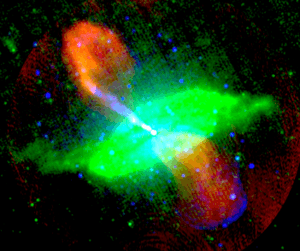Radio galaxy facts for kids

It shows radio (red), 24-micrometre infrared (green) and 0.5-5 keV X-ray emission (blue). The jet emits synchrotron radiation in all three wavebands:
• The red lobes only emit in the radio frequency range
• Gas and dust in the galaxy emits thermal radiation in the infrared
• Thermal X-ray radiation from hot gas relativistic electrons causes the blue 'shells' around the lobes to the south (bottom)
Radio galaxies and their relatives, radio-loud quasars and blazars, are types of active galaxy that are very luminous at radio wavelengths. They have luminosities up to 1039 W between 10 MHz and 100 GHz.
The radio emission is due to the synchrotron process. The observed structure in radio emission is determined by the interaction between twin jets and the external medium, modified by the effects of relativistic beaming. Radio galaxies are almost exclusively large elliptical galaxies. Radio-loud active galaxies can be detected at large distances, making them valuable tools for observation. Recently, much work has been done on the effects of these objects on the intergalactic medium, particularly in galaxy groups and clusters.
Images for kids
-
Pseudo-colour image of the large-scale radio structure of the FRII radio galaxy 3C98. Lobes, jet and hotspot are labelled.
-
Pseudo-colour image of the large-scale radio structure of the FRI radio galaxy 3C31. Jets and plumes are labelled.
See also
 In Spanish: Radiogalaxia para niños
In Spanish: Radiogalaxia para niños



